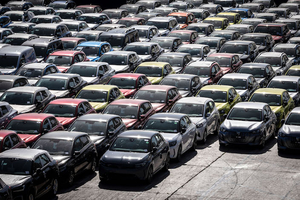Analysis: How Trump’s Tariffs Will Alter Global Automotive Supply Chain
Listen to the full version

On April 2, President Donald Trump unveiled a sweeping tariff policy imposing a 10% baseline levy on all trading partners, while giving details of how the 25% duties on automobiles and critical components first announced in late March would be implemented.
These extensive measures span nearly 150 product categories, covering both finished vehicles and crucial components including powertrains, lithium-ion batteries, and intelligent driving systems — an initiative that will disrupt global automotive supply chains and alter international trade dynamics.

Unlock exclusive discounts with a Caixin group subscription — ideal for teams and organizations.
Subscribe to both Caixin Global and The Wall Street Journal — for the price of one.
- DIGEST HUB
- President Trump imposed a 10% tariff on all trading partners and specific 25% tariffs on automobiles and components, affecting nearly 150 product categories and disrupting global automotive supply chains.
- China's auto component exports to the U.S. are expected to decline sharply, while tariffs may prompt China to strengthen ties with other economies like the EU, Japan, and South Korea.
- The tariffs could damage America's automotive industry more than China’s, increasing costs for American consumers and hindering cooperation with key global suppliers.
[para. 1] On April 2, President Donald Trump introduced a comprehensive tariff policy with a baseline 10% levy on all trading partners, focusing particularly on a 25% duty on automobiles and critical components. [para. 2] The tariffs encompass 150 product categories, including key automotive parts such as powertrains and lithium-ion batteries, significantly disrupting global automotive supply chains. [para. 3] The most substantial effect will be on Chinese products, with tariffs on electric vehicles (EVs) rising to 145% and gasoline vehicles to 70%, the same rate now applied to most automotive components from China.
[para. 4] In the context of the U.S.'s automobile industry, which produced over 10 million vehicles and exported 1.6 million in 2024, these tariffs aim to reshape trade dynamics. With imports fulfilling around half of U.S. market demands, primarily from Mexico, Canada, Japan, and South Korea, the intention is to mitigate trade deficits, boost tax revenues, and revitalize the American economy according to the White House. [para. 5][para. 6] However, the wide-reaching tariffs might ultimately harm American interests more than benefiting them, as they position the U.S. outside the global free trade framework. [para. 6] The policy might damage American interests in the long term, potentially being more detrimental to the U.S. than to China.
[para. 7] For China's automotive industry, the most significant impact is on the components sector, affecting $20 billion to $30 billion in U.S. parts exports. [para. 7][para. 8] Chinese auto parts to the U.S. are expected to drop considerably, and even overseas operations in ASEAN countries are under threat. [para. 9] In 2024, China exported $17.15 billion in automotive parts to the U.S., forming a significant part of its global exports, alongside notable lithium-ion battery exports. [para. 10][para. 11] These tariffs could prompt a sharp decline in Chinese component exports to the U.S. once entirely effectuated, despite typical inventory cycles and supply chain reorganization periods.
[para. 12][para. 13] China's retaliatory 34% tariffs on U.S. automotive imports will raise costs for domestic manufacturers, potentially encouraging foreign carmakers to localize production in China. [para. 14] While complete vehicle trade might see minimal disruption, the tariffs could incentivize China to deepen economic ties with the EU, Japan, and other nations.
[para. 15] The American automotive sector isn't immune. The sweeping 25% tariffs affect most vehicles and parts, potentially harming U.S. interests more than Chinese ones. [para. 16] Mounting pressures could ultimately hinder the full implementation of these measures, impairing U.S. cooperation with China and deteriorating trade relations with other global partners. [para. 17] The tariffs are expected to inflate costs for American consumers and challenge the North American Free Trade Area partners.
[para. 18] Trump's ambition to repatriate automotive manufacturing faces significant hurdles amid longstanding global supply chain developments. [para. 19][para. 20] The American economy's evolution from manufacturing towards technology and services further complicates the reversal efforts. Global automotive manufacturing, optimized through comparative advantages, has long established industrial clusters across different regions, reflecting a historical economic shift. [para. 21] As globalization redefined the automotive landscape, attempting to revert these changes challenges America’s adjusted competitive position.
[para. 22] Despite these challenges, America still holds significant competitive advantages, remaining an attractive destination for investment, particularly for Chinese companies heavily reliant on the U.S. market. [para. 23][para. 24] Nonetheless, tariffs will likely necessitate strategic selection of sectors and regions resilient to these pressures.
- 2023:
- Manufacturing's contribution to the U.S. GDP had shrunk to below 11%
- 2024:
- The U.S. produced more than 10 million vehicles and exported 1.6 million, with domestic sales reaching 16 million vehicles
- 2024:
- China exported $17.15 billion in automotive parts and $15.32 billion in lithium-ion batteries to the U.S., with a significant portion of global exports directed to America
- 2024:
- China exported 107,000 vehicles to America, while U.S.-manufactured imports to China totaled 109,000 vehicles
- MOST POPULAR






